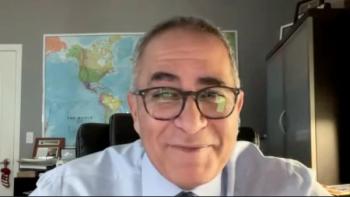
The Role of Transplant in Newly Diagnosed Multiple Myeloma
A panel of experts on multiple myeloma discuss the decision to refer patients with newly diagnosed multiple myeloma for transplant.
Episodes in this series

Transcript:
Peter Voorhees, MD: Hello, and thank you for joining this Cancer Network Satellite Session program titled “Treatment of Multiple Myeloma: Best Practices From Levine Cancer Institute and Satellites.” I’m Dr Peter Vorhees, clinical professor of medicine and chief of the plasma cell disorders division at the Levine Cancer Institute in Charlotte, North Carolina. Joining me today [are] my esteemed expert panelists. I would like to invite our panelists to introduce themselves.
Kwabena Osei-Boateng, MD: I’m Dr Kwabena Osei-Boateng. I’m a general hematologist and medical oncologist at Levine Cancer Institute Satellite Center at Lincolnton, [North Carolina].
Amy Soni, MD: I’m Amy Soni. I’m a general hematologist, seeing both benign and malignant hematology patients, and I practice at Levine Cancer Institute at University.
Reed Friend, MD: I’m Dr Reed Friend. I am a clinical assistant professor and practice at the Levine Cancer Institute in the Department of Hematologic Oncology and Blood Disorders at both South Park and Morehead.
Peter Voorhees, MD: Very good. Thank you all for joining me tonight. During the next 60 minutes of this program, we’re going to review the latest clinical evidence and discuss how physicians at Levine Cancer Institute and regional sites collaborate to improve outcomes for patients with multiple myeloma. All right, so we’re going to go ahead and begin, and the first thing we’re going to do is discuss treatment of transplant-eligible patients with newly diagnosed multiple myeloma. The first question I’m going to ask you guys, so for those patients with newly diagnosed multiple myeloma who are transplant eligible, who are you referring to us for consideration of transplant? Kwabena, I’ll start with you.
Kwabena Osei-Boateng, MD: So, generally, I think if they’re transplant eligible, based on their performance status, age, chronological and physiologic age, and comorbidities, then that that’s the preferred way of treating them. Because we know from data, IFM 2009 [NCT01191060], that there’s a PFS [progression-free survival] benefit in transplant. So, we tend to prefer that modality for the transplant-eligible patients.
Peter Voorhees, MD: Very good. Amy, when it comes to risk…so if a patient has standard-risk versus high-risk multiple myeloma as defined, for example, by cytogenetic profile, does that influence who you refer to us for consideration of stem cell transplant or would you refer either?
Amy Soni, MD: I would definitely refer either for consideration. I’m more likely to ask for an opinion potentially at the start of induction therapy if it’s someone with high-risk cytogenetics. But I would refer either for consideration.
Peter Voorhees, MD: And Reed, from an age perspective, is there a specific age cutoff where you would not refer a patient for consideration of stem cell transplant?
Reed Friend, MD: That’s a really good question because it’s hard to evaluate someone based on age alone. Assessing them with the IMWG [International Myeloma Working Group] frailty index to assess if they would be appropriate for transplant is appropriate. I don’t know that there’s necessarily an age cutoff per se, in my opinion.
Peter Voorhees, MD: I completely agree. It’s all about biologic age. It’s not so much about chronologic age. So, if you have a patient in their seventies who is very fit, they may, in fact, be a better candidate for stem cell transplant than a 60-year-old who is saddled with a number of different comorbidities.
Going back to the role of transplant in newly diagnosed multiple myeloma, let’s just touch briefly on upfront transplant vs deferred transplants of the patients where you collect cells and save them for a rainy day and potentially consider a stem cell transplant at relapse. Amy, do you have any strong feelings about doing it as part of frontline therapy versus doing it in a deferred fashion?
Amy Soni, MD: I wouldn’t say strong feelings, per se, but I think typically, I’ve done it from the beginning or at least sent patients for a conversation about doing it up front.
Peter Voorhees, MD: Yeah. You know, I think the data from the determination trial demonstrated that there’s no overall survival advantage to doing stem cell transplant as part of up-front therapy versus at the time of relapse. That said, the progression-free survival difference is quite striking for those patients who receive up-front transplant relative to at relapse. So, for those patients who are eligible, our general practice has been to encourage the use of up-front transplant and I think it’s better tolerated in that circumstance. That said, if you have a standard-risk patient, for example, who elects to defer transplant and collect cells, that’s not necessarily a wrong decision, either.
Transcript is AI-generated and edited for clarity and readability.
Newsletter
Stay up to date on recent advances in the multidisciplinary approach to cancer.

















































































